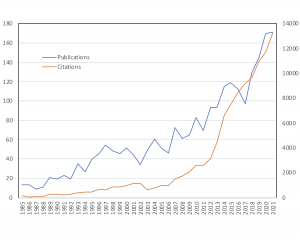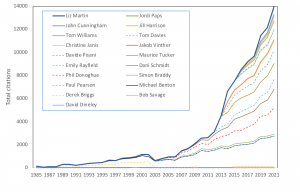Publications analysis
All members of the Bristol Palaeobiology Research Group publish their work. Publications include original scientific papers, published in the international scientific journals, reviews, books, and popular articles. Students are encouraged to publish their work, and we are especially proud that many excellent papers are published each year by our undergraduate and Masters students.

We now have fairly complete records of palaeontological publications by the group for the past 37 years, and this permits an overview and analysis of general and particular trends. Here is the graph (left) – what does it mean, and what are the limitations?
- The number of publications has risen more or less linearly from 10-20 per year in the 1980s to 100-180 in the past ten years.
- These increases perhaps reflect growth of the research group, from four in the 1980s (Briggs, Cowie, Dineley, Savage), down to two from 1989-1996 (Benton, Briggs), and then rising to eight in 2014 (Benton, Donoghue, Schmidt, Rayfield, Pisani, Vinther, Janis, Tucker), 11 in 2016 (addition of Davies, Harrison, Williams), and 13 in 2018 (addition of Cunningham, Paps).
- The population of MSc and PhD students, and postdocs and fellows has also grown substantially since 2000.
- Total citations have increased exponentially, from 20-40 per year in the 1980s, 100-300 per year from 1990-1995, then by annual increments of 100s to a global total of 7913 in 2017, 9258 in 2019, and 13282 in 2021. Note that the plot above reports annual totals – it is not cumulative.
Sources of data
Publication counts
- Publication details are taken from Google Scholar, and cross-checked with Scopus, searching for all publications with the author address of Department of Geology/ School of Earth Sciences at Bristol, and selecting those by members of the Palaeobiology Research Group
- Other sources, such as author cvs and obituaries, were searched to add non-listed publications. In more recent years (after 1997), the list has been compiled annually using Google Scholar and Scopus, and in consultation with members of the group, who help to fill gaps.
- The base data are compiled in our annual lists of publications here.
- We include only refereed scientific papers, books, and reviews, and exclude book reviews and popular articles (such as encyclopaedia entries, articles for popular magazines and websites, which are listed separately).
 Citation counts
Citation counts
- Citation counts are compiled according to the names of key members of staff
- Counts are made for the exact years during which those persons were in the Bristol department.
- If a person moved to another institution, their citation counts terminate when they left Bristol. For colleagues who retired or left the field, the citation clock keeps ticking for us.
- Citations are annual counts from Google-Scholar, except for David Dineley and Simon Braddy, whose citation counts come from Scopus.
- These are the people and years counted: David Dineley (1985 onwards), Bob Savage (1985 onwards), Derek Briggs (1985-2002), Michael Benton (1989 onwards), Paul Pearson (1995-2002), Simon Braddy (1996 onwards), Phil Donoghue (2003 onwards), Dani Schmidt (2004 onwards), Emily Rayfield (2005 onwards), Davide Pisani (2014 onwards), Jakob Vinther (2014 onwards), Christine Janis (2014 onwards), Maurice Tucker (2014 onwards), Tom Williams (2016 onwards), Tom Davies (2016-2020), Jill Harrison (2016 onwards), John Cunningham (2017 onwards), Jordi Paps (2019 onwards), and Liz Martin-Silverstone (2020 onwards).
Caveats
- Google-Scholar famously over-estimates citation counts, but Web of Science tends to under-estimate, and Scopus is incomplete before 1996.
- Citation counts during any year represent a cumulation of the impact of each person, including work they did before arriving in Bristol.
- We do not include research fellows and temporary staff in our counts, except when they published jointly with permanent staff members; many fellows publish most of their work independently, and so we underestimate those citation counts.
- Likewise, for colleagues who moved from Bristol to another institution, we cut off their citations immediately they go, even though their Bristol-based work continues to be cited.
- The quality of capture of citation data before 2000 is poor, and gets worse and worse back in time, leading to a substantial under-estimate in earlier years.
- Likely we have missed reporting many publications, especially before 1995. Before 2000, palaeontologists commonly published their work in books such as symposium volumes, obscure journals, and geological survey reports, which are largely not captured by online search tools.

